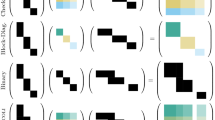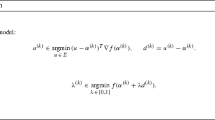Abstract
This work is about active set identification strategies aimed at accelerating block-coordinate descent methods (BCDM) applied to large-scale problems. We start by devising an identification function tailored for bound-constrained composite minimization together with an associated version of the BCDM, called Active BCDM, that is also globally convergent. The identification function gives rise to an efficient practical strategy for Lasso and \(\ell _1\)-regularized logistic regression. The computational performance of Active BCDM is contextualized using comparative sets of experiments that are based on the solution of problems with data from deterministic instances from the literature. These results have been compared with those of well-established and state-of-the-art methods that are particularly suited for the classes of applications under consideration. Active BCDM has proved useful in achieving fast results due to its identification strategy. Besides that, an extra second-order step was used, with favorable cost-benefit.













Similar content being viewed by others
Notes
The code is available at http://www.ime.unicamp.br/~pjssilva/code/abcd.
References
Andrew, G., Gao, J.: Scalable training of L1-regularized log-linear models. In: Proceedings of the 24th international conference on machine learning, ICML ’07, pp. 33–40. ACM, New York, NY, USA (2007). https://doi.org/10.1145/1273496.1273501
Beck, A., Tetruashvili, L.: On the convergence of block coordinate descent type methods. SIAM J. Optim. 23(4), 2037–2060 (2013). https://doi.org/10.1137/120887679
Berg, E.V., Friedlander, M.P., Hennenfent, G., Herrmann, F., Saab, R., Yılmaz, Ö.: SPARCO: a testing framework for sparse reconstruction. Technical Report TR-2007-20, Department of Computer Science, University of British Columbia, Vancouver (2007)
Boisvert, R.F., Pozo, R., Remington, K., Barrett, R.F., Dongarra, J.J.: Matrix market: a web resource for test matrix collections, pp. 125–137. Springer US, Boston, MA (1997). https://doi.org/10.1007/978-1-5041-2940-4_9
Boyd, S., Parikh, N., Chu, E., Peleato, B., Eckstein, J.: Distributed optimization and statistical learning via the alternating direction method of multipliers. Found. Trends Mach. Learn. 3(1), 1–122 (2010)
Bradley, J.K., Kyrola, A., Bickson, D., Guestrin, C.: Parallel coordinate descent for \(\ell _1\)-regularized loss minimization. In: ICML2011 (ed.) Proceedings of the 28th international conference on machine learning, pp. 1–8. The International Machine Learning Society, Bellevue, Washington, USA (2011). http://www.icml-2011.org/papers/231_icmlpaper.pdf
Candès, E.J., Recht, B.: Exact matrix completion via convex optimization. Found. Comput. Math. 9(6), 717–772 (2009). https://doi.org/10.1007/s10208-009-9045-5
Chang, C.C., Lin, C.J.: LIBSVM: a library for support vector machines. ACM Trans. Intell. Syst. Technol. (TIST) 2(3), 27 (2011)
Chen, T., Curtis, F., Robinson, D.: A reduced-space algorithm for minimizing \(\ell _1\)-regularized convex functions. SIAM J. Optim. 27(3), 1583–1610 (2017). https://doi.org/10.1137/16M1062259
Csiba, D., Qu, Z., Richtárik, P.: Stochastic dual coordinate ascent with adaptive probabilities. In: Proceedings of the 32nd international conference on international conference on machine learning, ICML’15, vol. 37, pp. 674–683. JMLR.org, Lille, France (2015). http://dl.acm.org/citation.cfm?id=3045118.3045191
Davis, T.A., Hu, Y.: The University of Florida sparse matrix collection. ACM Trans. Math. Softw. 38(1), 1:1–1:25 (2011). https://doi.org/10.1145/2049662.2049663
De Santis, M., Lucidi, S., Rinaldi, F.: A fast active set block coordinate descent algorithm for \(\ell _1\)-regularized least squares. SIAM J. Optim. 26(1), 781–809 (2016). https://doi.org/10.1137/141000737
Dolan, E.D., Moré, J.J.: Benchmarking optimization software with performance profiles. Math. Program. 91(2), 201–213 (2002). https://doi.org/10.1007/s101070100263
Donoho, D.L.: Compressed sensing. IEEE Trans. Inf. Theory 52(4), 1289–1306 (2006). https://doi.org/10.1109/TIT.2006.871582
Facchinei, F., Fischer, A., Kanzow, C.: On the accurate identification of active constraints. SIAM J. Optim. 9(1), 14–32 (1998). https://doi.org/10.1137/S1052623496305882
Fercoq, O., Richtárik, P.: Accelerated, parallel and proximal coordinate descent. SIAM J. Optim. 25(4), 1997–2013 (2015). https://doi.org/10.1137/130949993
Fountoulakis, K., Tappenden, R.: A flexible coordinate descent method. Comput. Optim. Appl. 70(2), 351–394 (2018). https://doi.org/10.1007/s10589-018-9984-3
Friedman, J., Hastie, T., Tibshirani, R.: Regularization paths for generalized linear models via coordinate descent. J. Stat. Softw. 33(1), 1–22 (2010). https://doi.org/10.18637/jss.v033.i01
Glasmachers, T., Dogan, U.: Accelerated coordinate descent with adaptive coordinate frequencies. In: Proceedings of the 5th Asian conference on machine learning (ACML), Proc. Mach. Learn. Res., vol. 29, pp. 72–86. PMLR, Australian National University, Canberra, Australia (2013). http://proceedings.mlr.press/v29/Glasmachers13.html
Kim, D., Sra, S., Dhillon, I.S.: A non-monotonic method for large-scale non-negative least squares. Optim. Methods Softw. 28(5), 1012–1039 (2013). https://doi.org/10.1080/10556788.2012.656368
Kim, S.J., Koh, K., Lustig, M., Boyd, S., Gorinevsky, D.: An interior-point method for large-scale \(\ell _1\)-regularized least squares. IEEE J. Sel. Top. Signal Process. 1(4), 606–617 (2007)
Komarek, P.: Paul Komarek’s webpage. http://komarix.org/ac/ds/. Accessed 29 January 2017
Lichman, M.: UCI Machine Learning Repository, University of California, Irvine, School of Information and Computer Sciences. http://archive.ics.uci.edu/ml. Last updated 23 July 2017. Accessed 01 September 2017
Mohri, M., Rostamizadeh, A., Talwalkar, A.: Foundations of Machine Learning. The MIT Press, Cambridge (2012)
Nesterov, Y.: Efficiency of coordinate descent methods on huge-scale optimization problems. SIAM J. Optim. 22(2), 341–362 (2012). https://doi.org/10.1137/100802001
Ng, A.Y.: Feature selection, \({L}_1\) vs. \({L}_2\) regularization and rotational invariance. In: Proceedings of the 21st international conference on machine learning, p. 354 (2004). http://www.machinelearning.org/proceedings/icml2004/papers/354.pdf
Patrascu, A., Necoara, I.: Efficient random coordinate descent algorithms for large-scale structured nonconvex optimization. J. Glob. Optim. 61(1), 19–46 (2015). https://doi.org/10.1007/s10898-014-0151-9
Qu, Z., Richtárik, P.: Coordinate descent with arbitrary sampling I: algorithms and complexity. Optim. Methods Softw. 31(5), 829–857 (2016). https://doi.org/10.1080/10556788.2016.1190360
Richtárik, P., Takáč, M.: Efficient serial and parallel coordinate descent methods for huge-scale truss topology design, pp. 27–32. Springer, Berlin, Heidelberg (2012). https://doi.org/10.1007/978-3-642-29210-1_5
Richtárik, P., Takáč, M.: Iteration complexity of randomized block-coordinate descent methods for minimizing a composite function. Math. Program. 144(1), 1–38 (2014). https://doi.org/10.1007/s10107-012-0614-z
Richtárik, P., Takáč, M.: Parallel coordinate descent methods for big data optimization. Math. Program. 156(1), 433–484 (2016). https://doi.org/10.1007/s10107-015-0901-6
Schmidt, M.: Graphical model structure learning with l1-regularization. Ph.D. thesis, University of British Columbia, Vancouver (2010)
Slawski, M.: Problem-specific analysis of non-negative least squares solvers with a focus on instances with sparse solutions (working paper) (2013). https://sites.google.com/site/slawskimartin/publications. Accessed 01 September 2017
Tappenden, R., Richtárik, P., Gondzio, J.: Inexact coordinate descent: complexity and preconditioning. J. Optim. Theory Appl. 170(1), 144–176 (2016). https://doi.org/10.1007/s10957-016-0867-4
Tibshirani, R.: Regression shrinkage and selection via the Lasso. J. R. Stat. Soc. Ser. B 58(1), 267–288 (1996)
Tseng, P., Yun, S.: A coordinate gradient descent method for nonsmooth separable minimization. Math. Program. 117(1), 387–423 (2009). https://doi.org/10.1007/s10107-007-0170-0
Wen, Z., Yin, W., Zhang, H., Goldfarb, D.: On the convergence of an active-set method for \(\ell _1\) minimization. Optim. Methods Softw. 27(6), 1127–1146 (2012). https://doi.org/10.1080/10556788.2011.591398
Wright, S.J.: Coordinate descent algorithms. Math. Program. 151(1), 3–34 (2015). https://doi.org/10.1007/s10107-015-0892-3
Wright, S.J., Nowak, R.D., Figueiredo, M.A.T.: Sparse reconstruction by separable approximation. IEEE Trans. Signal Process. 57(7), 2479–2493 (2009). https://doi.org/10.1109/TSP.2009.2016892
Yuan, M., Lin, Y.: Model selection and estimation in regression with grouped variables. J. R. Stat. Soc. Ser. B (Stat. Methodol.) 68(1), 49–67 (2006). https://doi.org/10.1111/j.1467-9868.2005.00532.x
Acknowledgements
We are thankful to the comments and suggestions of two anonymous referees, which helped us to improve the presentation of our work.
Author information
Authors and Affiliations
Corresponding author
Additional information
Publisher's Note
Springer Nature remains neutral with regard to jurisdictional claims in published maps and institutional affiliations.
Partially supported by FAPESP Grants 2014/14228-6, 2013/05475-7, and 2013/07375-0 and CNPq Grants 306986/2016-7, and 302915/2016-8.
Rights and permissions
About this article
Cite this article
Lopes, R., Santos, S.A. & Silva, P.J.S. Accelerating block coordinate descent methods with identification strategies. Comput Optim Appl 72, 609–640 (2019). https://doi.org/10.1007/s10589-018-00056-8
Received:
Published:
Issue Date:
DOI: https://doi.org/10.1007/s10589-018-00056-8
Keywords
- Block coordinate descent
- Active-set identification
- Large-scale optimization
- \(\ell _1\) Regularization




